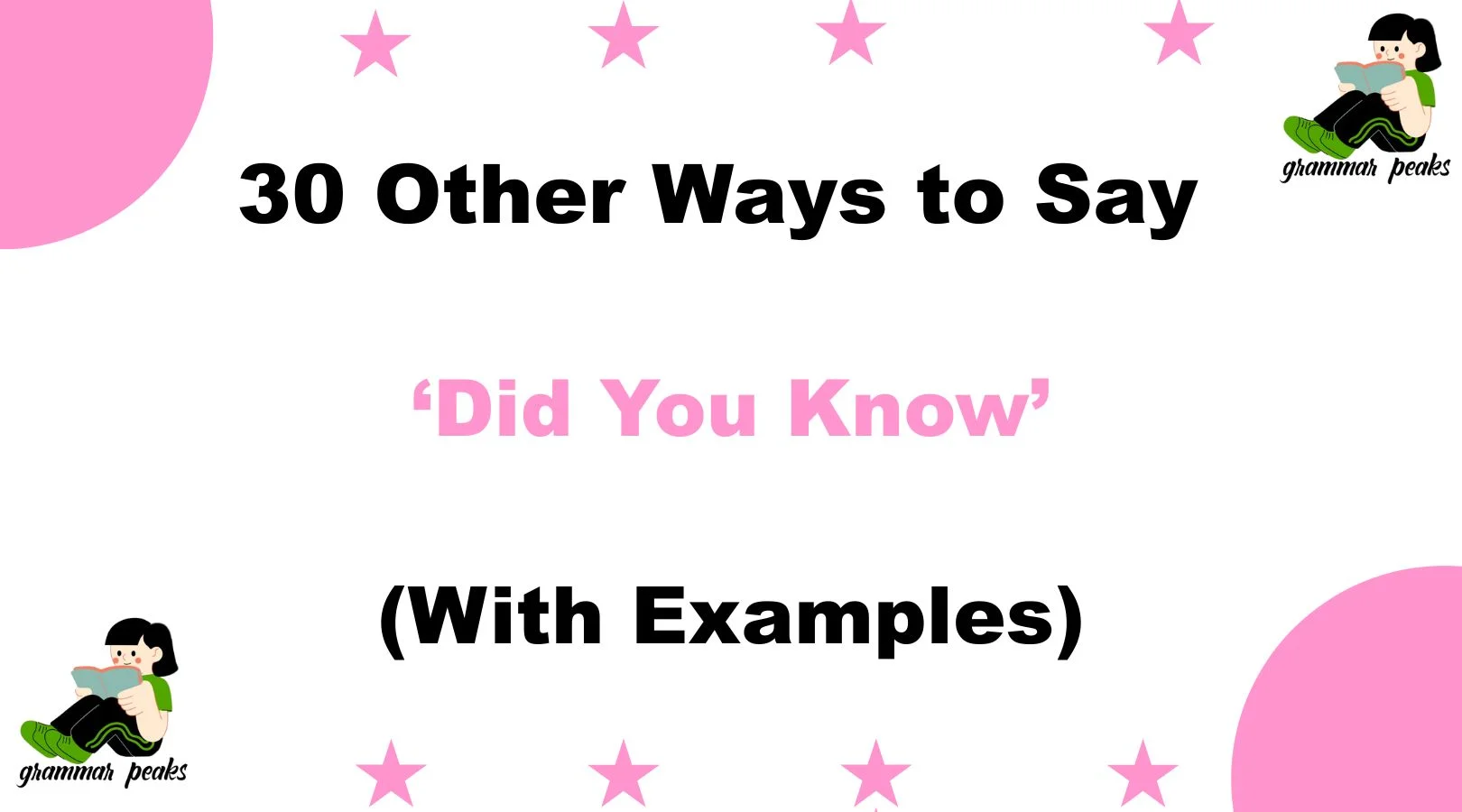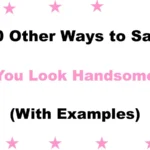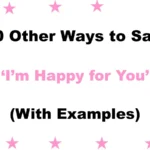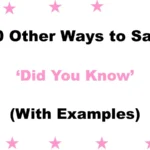When you’re trying to share something interesting, how you say it matters just as much as what you say. Phrases like “Did you know” are common—but using the same wording over and over can make your message feel robotic or repetitive. Whether you’re writing a blog, giving a presentation, or simply having a meaningful conversation, finding the right alternative helps your facts land more naturally and thoughtfully. In this guide, you’ll discover 30 heartfelt, clever, and empathetic ways to say “Did you know”—all designed to help your words feel more personal, warm, and engaging.
What Does “Did You Know” Mean?
“Did you know” is a phrase used to introduce a fact, insight, or piece of trivia that may be new or surprising to someone. It’s often used to spark curiosity, start a conversation, or share knowledge in a friendly or informative way. Whether in writing or speech, it helps draw attention to something interesting. It’s a simple yet powerful tool to engage and educate your audience.
When to Use “Did You Know”
Use “Did you know” when you want to:
- Share educational content
- Present curious or fun facts
- Encourage thoughtful reflection
- Start a conversation or hook an audience
It’s most effective when you genuinely believe the information will be interesting or useful to the person you’re talking to.
Is It Professional/Polite to Say “Did You Know”?
Yes—“Did you know” is professional, polite, and appropriate for most settings. However, depending on tone or delivery, it can sound a bit dry or scripted. In more refined communication or sensitive topics, using alternatives can help your message come across as more considerate and conversational.
Pros and Cons
Pros:
- Immediately grabs attention
- Universally understood
- Easy to use in writing or speech
Cons:
- Can feel overused or dull
- May sound like a quiz
- Lacks emotional warmth or personal tone
Synonyms for “Did You Know”
- Here’s something you might find interesting
- Just in case you haven’t heard
- Fun fact:
- I came across something surprising
- You might be surprised to learn
- It turns out that…
- Thought you might like this
- You may not have noticed, but…
- Allow me to share something
- Guess what I learned
- Here’s something worth knowing
- Ever heard this before?
- I recently discovered
- I found this fascinating
- This blew my mind
- I learned something new today
- You’ll appreciate this
- This might be useful to you
- You probably didn’t expect this
- Something curious popped up
- Have you ever realized…
- Something worth thinking about
- A little-known truth is
- It’s easy to miss this
- Something to keep in mind
- Did it ever occur to you that…
- I wonder if you’ve seen this
- This caught my attention
- You’ll love this detail
- Here’s a gem I stumbled on
1. Here’s something you might find interesting
Definition: A gentle way to introduce a piece of information.
Detailed Explanation: This phrase comes across as friendly and thoughtful, inviting the listener in rather than quizzing them.
Scenario Example: “Here’s something you might find interesting—honey never spoils.”
Best Use: Personal messages, blogs, or classroom settings.
Worst Use: May feel vague in highly technical or formal writing.
Tone: Warm, curious, and non-intrusive.
2. Just in case you haven’t heard
Definition: A soft, conversational way to share new or surprising info.
Detailed Explanation: This suggests you’re not assuming the other person doesn’t know, but just offering something that might be new to them.
Scenario Example: “Just in case you haven’t heard, whales can hold their breath for over an hour.”
Best Use: Email updates, newsletters, casual chats.
Worst Use: Too casual for academic papers.
Tone: Casual, polite, friendly.
3. Fun fact:
Definition: A catchy and playful intro to an interesting tidbit.
Detailed Explanation: It’s direct and upbeat, often used in informal or entertaining content.
Scenario Example: “Fun fact: Bananas are technically berries, but strawberries aren’t.”
Best Use: Presentations, Instagram captions, informal writing.
Worst Use: Too cheeky for serious or somber topics.
Tone: Playful, energetic.
4. I came across something surprising
Definition: A phrase that signals discovery and excitement.
Detailed Explanation: It builds natural curiosity and keeps the tone personal and sincere.
Scenario Example: “I came across something surprising—your heartbeat syncs with the music you listen to.”
Best Use: Blog posts, personal letters, discussion forums.
Worst Use: Less effective for hard-hitting or scientific content.
Tone: Reflective, engaging, casual.
5. You might be surprised to learn
Definition: A teaser that implies the information will challenge assumptions.
Detailed Explanation: Great for setting up mind-blowing or ironic facts that engage curiosity.
Scenario Example: “You might be surprised to learn that octopuses have three hearts.”
Best Use: Science articles, public speaking, educational content.
Worst Use: Avoid if overused—it can sound clickbaity.
Tone: Intriguing, slightly dramatic.
6. It turns out that…
Definition: A phrase used to reveal a surprising conclusion or fact.
Detailed Explanation: Creates a narrative feel—perfect when explaining cause and effect or context.
Scenario Example: “It turns out that the Eiffel Tower can grow taller in the summer due to heat expansion.”
Best Use: Informative storytelling, blog articles, science writing.
Worst Use: Not ideal as a stand-alone without context.
Tone: Conversational, explanatory.
7. Thought you might like this
Definition: A considerate way to share a fact based on the recipient’s interests.
Detailed Explanation: Makes your message feel personal and empathetic.
Scenario Example: “Thought you might like this—sloths can hold their breath longer than dolphins!”
Best Use: Personal messages, DMs, emails to colleagues.
Worst Use: Ineffective for broader audiences.
Tone: Friendly, tailored, caring.
8. You may not have noticed, but…
Definition: A soft way to highlight an overlooked detail.
Detailed Explanation: This makes you sound helpful, not critical, especially in team or group discussions.
Scenario Example: “You may not have noticed, but Monday’s full moon was the brightest of the year.”
Best Use: Group chats, feedback, awareness posts.
Worst Use: Avoid if the recipient might take it as criticism.
Tone: Subtle, respectful.
9. Allow me to share something
Definition: A formal and polite way to begin a fact or insight.
Detailed Explanation: Adds a tone of courtesy and confidence, great for professional or educational settings.
Scenario Example: “Allow me to share something—bamboo is technically a grass, not a tree.”
Best Use: Speeches, presentations, professional writing.
Worst Use: Too stiff for casual chats.
Tone: Respectful, professional.
10. Guess what I learned
Definition: A fun, curious lead-in to a discovery.
Detailed Explanation: Engages the listener emotionally and makes the interaction feel like a shared moment.
Scenario Example: “Guess what I learned—pigeons can recognize themselves in a mirror!”
Best Use: Friendly texts, podcasts, social conversations.
Worst Use: Too informal for business or research.
Tone: Curious, spontaneous, informal.
11. Here’s something worth knowing
Definition: A considerate phrase suggesting the information may be valuable.
Detailed Explanation: It invites curiosity while showing respect for the reader’s attention—it feels like you’re offering something useful, not just random trivia.
Scenario Example: “Here’s something worth knowing—your brain uses more energy when you’re daydreaming than solving math problems.”
Best Use: Educational content, newsletters, professional conversations.
Worst Use: May sound too vague if not followed by relevant info.
Tone: Warm, sincere, purposeful.
12. Ever heard this before?
Definition: A casual, conversational prompt to introduce a new or interesting fact.
Detailed Explanation: It engages the reader or listener and encourages participation—almost like a mini quiz without the pressure.
Scenario Example: “Ever heard this before? Flamingos are born gray, not pink.”
Best Use: Informal chats, social media, classroom interactions.
Worst Use: May feel too playful for formal writing.
Tone: Fun, inviting, conversational.
13. I recently discovered
Definition: A personal way to share new knowledge or insight.
Detailed Explanation: It signals that the fact is fresh and exciting to you, which naturally encourages curiosity in others.
Scenario Example: “I recently discovered that jellyfish have survived five mass extinctions.”
Best Use: Blogs, personal writing, storytelling.
Worst Use: May feel too self-focused in group discussions.
Tone: Curious, thoughtful, sincere.
14. I found this fascinating
Definition: A phrase that introduces something personally intriguing.
Detailed Explanation: By expressing your own genuine interest, you invite the reader to engage with the same sense of wonder.
Scenario Example: “I found this fascinating—sea otters hold hands while sleeping to keep from drifting apart.”
Best Use: Social posts, newsletters, personal anecdotes.
Worst Use: May fall flat if the fact isn’t actually fascinating.
Tone: Engaging, personal, warm.
15. This blew my mind
Definition: A very casual and expressive way to introduce a shocking or unexpected fact.
Detailed Explanation: It’s great for surprising or ironic trivia, especially with a younger or more casual audience.
Scenario Example: “This blew my mind—sharks existed before trees!”
Best Use: TikTok, YouTube intros, blog hooks.
Worst Use: Too informal for academic or corporate writing.
Tone: Playful, bold, dramatic.
16. I learned something new today
Definition: A humble and reflective way to share knowledge.
Detailed Explanation: This makes your message feel inclusive, like you’re inviting someone into your own journey of learning.
Scenario Example: “I learned something new today—octopuses have nine brains!”
Best Use: Educational writing, reflective posts.
Worst Use: May seem vague without context.
Tone: Curious, grounded, humble.
17. You’ll appreciate this
Definition: A friendly and personalized way to share something meaningful.
Detailed Explanation: This suggests you know the person’s interests or values, making it feel tailored and thoughtful.
Scenario Example: “You’ll appreciate this—birds are the closest living relatives to dinosaurs.”
Best Use: Personal messages, mentor notes, relationship-building.
Worst Use: Doesn’t work well for general audiences.
Tone: Warm, friendly, attentive.
18. This might be useful to you
Definition: A practical intro that highlights potential relevance.
Detailed Explanation: This approach is helpful when sharing tips, tools, or strategies, especially in educational or professional content.
Scenario Example: “This might be useful to you—Ctrl + Shift + T reopens your last closed browser tab.”
Best Use: Tipsheets, email marketing, coaching.
Worst Use: May sound dry for casual or fun facts.
Tone: Supportive, practical.
19. You probably didn’t expect this
Definition: A teaser phrase to lead into a surprising or ironic fact.
Detailed Explanation: It’s attention-grabbing and best used when your goal is to spark interest quickly.
Scenario Example: “You probably didn’t expect this—bananas are technically radioactive.”
Best Use: Presentations, videos, engaging intros.
Worst Use: Can come off as gimmicky if overused.
Tone: Surprising, energetic.
20. Something curious popped up
Definition: A relaxed and informal way to introduce unexpected knowledge.
Detailed Explanation: It gives the impression of a spontaneous discovery, which makes the interaction feel natural and conversational.
Scenario Example: “Something curious popped up—wombat poop is cube-shaped!”
Best Use: Blogs, personal chats, trivia forums.
Worst Use: Not ideal for formal or educational papers.
Tone: Light, casual, whimsical.
21. Have you ever realized…
Definition: A reflective prompt encouraging someone to think differently.
Detailed Explanation: It’s great for philosophical, emotional, or surprising insights—more thoughtful than playful.
Scenario Example: “Have you ever realized that your brain can’t feel pain itself?”
Best Use: Thought leadership, blog posts, podcasts.
Worst Use: May confuse readers if the sentence isn’t clearly structured.
Tone: Reflective, deep, curious.
22. Something worth thinking about
Definition: A subtle prompt to introduce a fact with weight or meaning.
Detailed Explanation: This phrase works well when the insight has emotional, social, or philosophical depth.
Scenario Example: “Something worth thinking about—trees communicate through underground fungi networks.”
Best Use: Social commentary, essays, opinion pieces.
Worst Use: Doesn’t suit fun or casual facts.
Tone: Thoughtful, meaningful.
23. A little-known truth is
Definition: A slightly formal phrase for sharing surprising or obscure facts.
Detailed Explanation: It positions your fact as rare and insightful, which can build credibility and engagement.
Scenario Example: “A little-known truth is that Napoleon was actually taller than average for his time.”
Best Use: Articles, infographics, trivia segments.
Worst Use: Too heavy for quick social chats.
Tone: Informative, curious.
24. It’s easy to miss this
Definition: A phrase that points to commonly overlooked details.
Detailed Explanation: Helps readers feel included rather than uninformed—it’s helpful, not superior.
Scenario Example: “It’s easy to miss this—there’s a tiny owl hidden in the dollar bill’s design.”
Best Use: Visual content, blog posts, design reviews.
Worst Use: May feel unnecessary if the fact isn’t subtle.
Tone: Observant, helpful, subtle.
25. Something to keep in mind
Definition: A neutral phrase often used to introduce important or reflective info.
Detailed Explanation: It suggests the information is worth remembering, useful in both casual and serious content.
Scenario Example: “Something to keep in mind—passwords with four words are often stronger than complex characters.”
Best Use: Safety tips, wellness content, educational material.
Worst Use: Not ideal for trivia or fun facts.
Tone: Cautious, wise, informative.
26. Did it ever occur to you that…
Definition: A reflective and gentle question to prompt realization.
Detailed Explanation: Ideal for nudging deeper thinking in conversation or writing.
Scenario Example: “Did it ever occur to you that goldfish can remember things for months?”
Best Use: Philosophy, science, psychology topics.
Worst Use: May sound condescending if overused.
Tone: Thoughtful, curious.
27. I wonder if you’ve seen this
Definition: A gentle introduction to visual or surprising facts.
Detailed Explanation: This works especially well when paired with images or data and avoids sounding like a lecture.
Scenario Example: “I wonder if you’ve seen this—an x-ray of a pregnant seahorse.”
Best Use: Social media, group chats, presentations.
Worst Use: Lacks clarity if not followed by something visual.
Tone: Friendly, soft, visually oriented.
28. This caught my attention
Definition: A personal and honest intro that shows your curiosity.
Detailed Explanation: It draws people in because it’s relatable and human, like a friend sharing a discovery.
Scenario Example: “This caught my attention—Venus rotates in the opposite direction of Earth.”
Best Use: Blog intros, casual emails, conversation starters.
Worst Use: Ineffective if overused or irrelevant.
Tone: Curious, casual, authentic.
29. You’ll love this detail
Definition: A confident and affectionate way to share an exciting tidbit.
Detailed Explanation: Works beautifully when you know the person’s interests or sense of humor.
Scenario Example: “You’ll love this detail—koalas have fingerprints almost identical to humans.”
Best Use: Personalized messages, social posts, fun newsletters.
Worst Use: May feel presumptuous in professional settings.
Tone: Enthusiastic, charming, tailored.
30. Here’s a gem I stumbled on
Definition: A whimsical and personal way to introduce rare or delightful facts.
Detailed Explanation: Makes the information feel like a hidden treasure, adding charm and playfulness.
Scenario Example: “Here’s a gem I stumbled on—some turtles can breathe through their butts!”
Best Use: Blog posts, trivia nights, playful conversations.
Worst Use: Not suitable for serious or formal content.
Tone: Quirky, fun, lighthearted.
Conclusion
“Did you know” is a dependable phrase, but it can feel worn out or robotic if used too often. With these 30 heartfelt, curious, and polished alternatives, you can share facts, ideas, and surprises in a way that connects emotionally and sparks real interest. Whether you’re a teacher, a writer, a leader, or a friend, the words you choose shape how people feel about what you’re saying. The key is to be thoughtful, authentic, and creative—and now you’ve got the tools to do just that.
FAQs
1.What Does “Did You Know” Mean in Conversation?
“Did you know” is a commonly used phrase to introduce a fact, idea, or piece of trivia that may be new, surprising, or interesting to the listener. It’s often used to spark engagement, curiosity, or learning—whether in a classroom, a fun conversation, or content writing.
2.Is “Did You Know” Considered Professional?
Yes, “Did you know” is professional and appropriate in most workplace or educational settings. However, using a more tailored or thoughtful alternative can help your message feel less formulaic and more audience-focused—especially in emails, presentations, or content marketing.
3.Why Should I Use Alternatives to “Did You Know”?
Using thoughtful alternatives to “Did you know” helps your message feel more genuine, engaging, and human. It prevents repetition and allows you to better match your tone to your audience—whether that’s playful, formal, reflective, or curious.
4.Which Alternatives Work Best for Professional Writing?
Here are a few great options for formal or professional settings:
- “Here’s something worth knowing”
- “Allow me to share something”
- “This might be useful to you”
These sound polite and informative without being too casual or quirky.
5.Can I Use These Alternatives in Speeches or Presentations?
Absolutely. Many of these alternatives are ideal for public speaking, including:
- “You might be surprised to learn…”
- “It turns out that…”
- “Have you ever realised…”
They help keep your audience engaged and add personality to your delivery.






